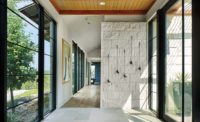
Built in honor of its namesakes, the Ewing and Muriel Kauffman Memorial Garden was a gift to the citizens of Kansas City, MO. Free of charge to the public, the two-acre site offers visitors a relaxing environment complete with vibrant-colored plants, large water fountains and decorative sculptures. Adding to the aesthetics of the premises are the rough-textured limestone walls and archways, which were quarried and fabricated in
the region.
"We were looking for a local stone -- something that replicated the very fine stonework that exists in Kansas City," said Principal-In-Charge Melissa Marshall of Marshall Tyler Raufch in Pittsburgh, PA. "We looked at quite a bit of stone. Part of what we did was look for older quarries. We located ones that have existed since the '20s and '30s. We wanted an old stone supplier."
After extensive research, the design team at Marshall Tyler Raufch chose limestone quarried by Bayer Stone, Inc. of St. Marys, KS. Now owned and operated by the third generation of the Bayer family, the company has been in existence since 1930.
"We had many mock-ups from other local stone suppliers in the area," said Marshall. But in the end, Top Ledge Cottonwood Cut Stone from Bayer Stone was selected. The material was used for coping, pavers, radius window surrounds, arched gates, arches in the orangery and smooth face base stone in the interior and exterior. Additionally, approximately 500 tons of Cottonwood Sawed Bed Split Face veneer in three heights -- 31/2, 7 1/2 and 111/2 inches -- were employed for the project.
The use of the local limestone not only enhanced the architectural appearance of the garden, but also blended with the surrounding area. The Kauffmans were very involved in the culture of Kansas City, and it is only appropriate that regional products play a part in their memorial.
The limestone was given a bushhammered finish, which gave texture and a more rustic look to the stone. "Six different sizes were used to create mock-ups to get an interlocking look," said the architect. "We don't like stone to look bedded. We didn't want a horizontal line to go for more than three stones at a time. Stonework is as good as the mason is. It took us a while to figure out what we liked."
The design team supplied drawings to the masons of what they wanted the stone pattern to look like, explained Marshall. "They did mock-ups," she said. "They had different joint patterns in them, and we selected the joints and the patterns."
It took about three days before the final pattern was chosen, according to Royce Brock of J.E. Dunn Contractors Co. in Kansas City, MO, the general contractor and installer for the project. "They looked at three samples," he said, adding that once the pattern was selected, there wasn't much difficulty installing it. "We made the pieces the length in the field. We made our own pattern and cut the stone to our own please there."
White Portland Type N mortar was used to piece the stone together, and most applications were backed up with block, according to Brock. At its peak, the project had a crew of 10 stonemasons working on site. Initial work began on the garden in September 1998, and the project opened to the public in May 2000.

Designing the memorial
Ewing Marion Kauffman was an entrepreneur, Major League Baseball team owner and philanthropist. In 1950, he founded Marion Laboratories Inc., which was sold to Merrell Dow in 1989 and became a global diversified pharmaceutical giant with annual sales of nearly $1 billion. He also brought Major League Baseball back to Kansas City in 1968, when he purchased the Kansas City Royals. This helped to boost the city's economic base and community profile as well as civic pride. As another gesture to help his community, Kauffman established a foundation in the mid-1960s to help others live self-sufficiently in healthy environments. The Foundation became fully funded after Ewing Kauffman died in 1993.The Kauffman Memorial Garden was dedicated by Ewing and Muriel's daughter, Julia. "The garden is a series of rooms -- mostly formal -- built around an orangery," said Marshall. "The orangery is a special kind of greenhouse with a solid north wall and arched windows on the south built to house potted palms, gardenias, jasmine and other fragrant plants selected to bloom in the winter. The entrance to the garden is a hornbeam all?underplanted with flowers and foliage plants in shades of blue, pink, lavender and silver. The Central Garden in front of the orangery has a lily pool surrounded by a lawn, raised planters and a long pergola hung with flowers. Everywhere there are places to perch on walls, on the grass or in the shade and enjoy lunch or a visit listening to the sound of the fountains."
The architect went on to explain that there is a Canal Garden, which has a long linear pool with bronze figures dancing through sprays of water. "Tucked behind the orangery is the walled Secret Garden overgrown with plants and full of places to sit. Hidden jets of water erupt randomly from the lush plantings, adding a playful note and the splash of water," said Marshall.
In total, the garden features 7,000 plants. Trees on the property resemble the Canadian woods, specifically blue spruce and maples, to represent Muriel Kauffman's Canadian heritage.

End box
The Ewing and Muriel Kauffman Memorial Garden, Kansas City, MOArchitect: Marshall Tyler Raufch, Pittsburgh, PA
General Contractor/Installer: J.E. Dunn Construction Co., Kansas City, MO
Stone Quarrier/Fabricator: Bayer Stone, Inc., St. Marys, KS





